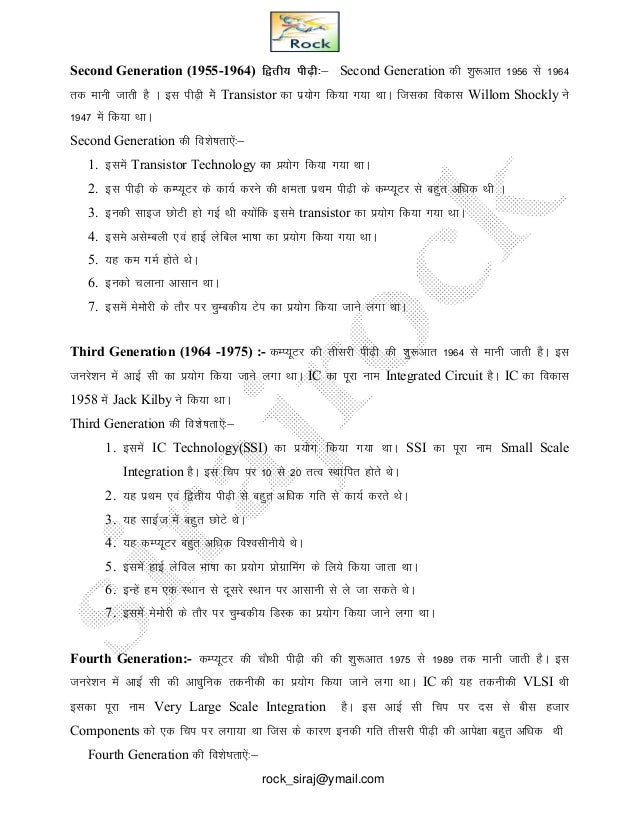Generation Of Computer In Hindi
Second generation के computers में transistors ने vaccum tubes की जगह ले ली. Transistor बहुत ही कम जगह लेते थे, छोटे थे, faster थे, सस्ते थे और ज्यादा Energy Efficient थे. (What is Computer in Hindi). Generation of Computers First Generation Second Generation Third Generation Fourth Generation Fifth Generation. Generations of Computers The evolution of computers can be divided into five generations. Each generation represents technological evolutions over the period of time. Each generation of computers resulted in better, cheaper and smaller computers that are more powerful, faster and efficient than the previous generation. This entry was posted in FUNDAMENTAL and tagged computer fundamental in hindi, computer generation, computer generation hindi, computer ki generation kya hai, first generation second generation third generation forth generation fifth generation ke computer, generation of computer in hindi by PRAMOD. Bookmark the permalink.

Generation Of Computer In Hindi And English

ABOUT MEHELLO I AM MOHD TARIQ FAROOQUII AM EDUCATOR OF UNACADEMY SINCE AUGUST 2018Bachelor in Computer Application from MCRPV (BHOPAL)Diploma in Architecture Visualiser from LucknowQualified ibps clerk ,SSC CGL, 2 Time qualified highcourt clark and also 1 time cracked upsssc examI have more than two years experience of teachingHOBBIES :- Playing cricket,Going GYM, Watching moviefollow me on unacademyppmy name on unacademy aMOHD TARIQ FAROOQUI
3-4 viewsMohd Tariq FarooquiEducator since August 2018Bachelor in computer application(BCA) from MCPRPV university (bhopal). Diploma in architecturevisualiser from icad institute lucknow.. 259 2 11Folowers Folowing CoursesFollowunacdemyAll coursesHINDI Mock Test(Hindi) Previous Years Paper WithSolutions: Banking0 (0 ratings)Prek- earQoestion PapersMohd Tariq Farooqui
microprocessorfourth generation computer 1971 todayGeneration ofcomputerery important for all
Generation of computerComputer generation classification is manly based on the basicdevice used also the consideration are the architecture,language, modes of operation etc.The function performed by the speed of their operation havebeen changing since the old day to the most modern computer.Based on the period of development and the featuresincorporated the computer are classified into different.The classification and time periods1. First generation computer (1945-1955)2. Second generation computer (1957-1963)3. Third generation computer (1964-1971)4. Fourth generation computer (1971-onward)5. Five generation computer (present and future)
Generation of computersecond generation computer (1957-1963)Second Generation: TransistorsThe world would see transistors replace vacuum tubes in the secondgeneration of computers. The transistor was invented at Bell Labs in1947 but did not see widespread use in computers until the late1950sThe transistor was far superior to the vacuum tube, allowingcomputers to become smaller, faster, cheaper, more energy-efficientand more reliable than their first-generation predecessors. Thoughthe transistor still generated a great deal of heat that subjected thecomputer to damage, it was a vast improvement over the vacuumtube. Second-generation computers still relied on punched cards forinput and printouts for output.From Binary to Assembly
Generation of computer. Second-generation computers moved from cryptic binarymachine language to symbolic, or assembly , languages, whichallowed programmers to specify instructions in words.. High-level programming languages were also being developed atthis time, such as early versions of COBOL and FORTRAN . Thesewere also the first computers that stored their instructions in theirmemory, which moved from a magnetic drum to magnetic coretechnology.The first computers of this generation were developed for theatomic energy indus